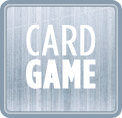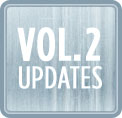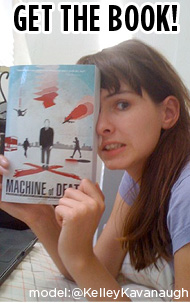Monthly ArchiveMay 2011
Vol2 Updates 27 May 2011 06:01 am
Five reasons YOU should submit to Machine of Death today!
There are about six weeks left until our Volume 2 submissions deadline of July 15. If you haven’t submitted a story yet, here are a few reasons why we think you should consider it!
#1 The challenge: Several writers have told us that writing a Machine of Death story was the most fun they’d had with their word processors in a long time. As editors, we know exactly what they mean. Not only have we personally written more Machine of Death stories than we can print (we can’t help ourselves!), but we’ve seen dozens of examples of how the apparent limits can yield endless possibilities once those creative juices get flowing.
#2 The money: This is about as simple as it gets. It doesn’t cost anything to submit your story or art portfolio. But if you get selected for the book, then you get $200 in cold, hard cash. That’s pretty good!
#3 The exposure: The first book has thousands of readers so far (and more every week!), and is available in bookstores across the U.S. and Canada. Plus many of our contributors got the thrill of seeing their names mentioned in reviews by Strange Horizons, The Onion AV Club, Tor.com, Jeff VanderMeer, and others. Take it from us – this stuff is cool! And though we can’t make any promises, we’re doing everything we can to make the next book even bigger.
#4 The opportunities: This is more than just a book to us! We love this idea so much that we take any chance to push it in new directions. This includes the live show that we had last month in Hollywood, as well as slightly more low-key events (both impromptu and planned) at conventions we attend. And we love it when Machine of Death contributors join us for these events. It’s a great chance to meet some real, live fans who think your work is great!
#5 The unexpected: We hadn’t even imagined half the stuff on this list when we put out the first book last October. But when the book started selling, we decided to run with it as far as we could go. We’re still running today, and we don’t think we’ve reached the end of the surprises yet. But only time will tell what those surprises will be!
Look, at the end of the day, we can’t make any promises about how successful the next book will be, or how many people will read it, or whether it will get turned into a blockbuster movie starring Natalie Portman and Jake Gyllenhaal as hot, young scientists who accidentally change the world. As much as we’d like to, we can’t directly control any of that.
But we do know that the next book is going to be awesome and that it’s going to be a lot of fun to be involved with. We’re all incredibly excited to have this opportunity again and we really hope you’ll join us too! So get to work!
Reader Mail 24 May 2011 06:35 pm
Death Prediction Requests Round One
Hello! My name is Robynne. I’ve been helping David ! with some of the requests people have sent in for death prediction cards.
Anyone can get their very own death prediction, for free! And tons of people already have. The only requirement is that you send something in return. If you mail us some small item in trade for the card, and you include a self-addressed stamped envelope, we’ll mail you a death prediction!
Some people have sent in scraps of paper; some have sent in elaborate works of art. Some write long letters; some provide no note of explanation whatsoever. Looking over the eclectic variety of items that has accumulated in this office is terrifically exciting. So David has invited me to write about some of my favorite items that people have sent us in return for their death predictions.
This is a pretty awesome drawing! It’s got tons of details, a lot of action, cool patterns and shapes… I’m glad I got to see it! Many thanks to the artist for sending it in.
This is pretty much exactly the level of thing that is hoped for with these card requests. It’s clever, fun, and simple. A small experience that can brighten one’s day a little bit.
I happen to collect Disney theme park memorabilia. I don’t have one of these buttons, though I’d like one. I know if I had one I would never let it go, ever. I’m quite impressed that somebody out there willingly parted with theirs.
That’s all for now, but there are tons of things remaining that people have sent in that I’m looking forward to sharing with you! Opening all of these letters has been such a fun process!
Podcast Episodes 23 May 2011 10:01 pm
Podcast 16: STARVATION, by M. Bennardo
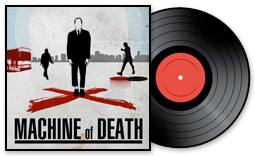
“STARVATION,” by M. Bennardo.
Read by Brian Swanson. (36 min)
Johnny straggled behind Dalton as they came out of the jungle into the clearing. Streaks of fuel burned in the grass, the flames pale and languid in the bright midday sun. But they were still hot and smoky as hell. The smashed chopper was only about twenty yards away, a crumpled aluminum can surrounded by four smoldering lumps of black. The rest of the men.
Dalton brought the nose of his rifle up and put his finger on the trigger. They hadn’t seen any enemy fire when they had gone down, but it was hard to be sure. And even if the bad guys hadn’t been around before, there was nothing like a crippled chopper to bring them out of cover. “Keep your eyes open,” said Dalton. Johnny just grunted, and drew his knife. It was the only weapon he had anymore.
Download the MP3 • Subscribe on iTunes
Direct podcast feed: http://feeds.feedburner.com/machineofpodcast
M. Bennardo‘s stories have been published in Asimov’s Science Fiction and Strange Horizons, among other markets. He is also one of the co-editors of Machine of Death. He lives in Cleveland, Ohio.
Brian Swanson is one-half of FoxSwan, a comedy karaoke duo based in Burbank, California. He is currently on a mission to sing karaoke with Meat Loaf.
In the book, “STARVATION” is illustrated by Karl Kerschl. This podcast episode was edited by Matthew Schwartz.
Vol2 Updates 20 May 2011 08:06 pm
A short Q&A about submissions
Lots of people have been using the “Ask Us Anything” form on the contact page recently, which is great! We love hearing from you guys, and we try to give a prompt reply. (If we don’t promptly reply, it probably means that we’re thinking really hard to give you the best possible answer.) Since there have been a few questions lately about what kinds of works we’d consider for the book, I figured I’d take the time to address some of that here. (If you haven’t read the submission guidelines yet, you can do that here.)
Will you consider really short works? Like a joke or a haiku?
Mostly we’re looking for short stories that fall in the range of 1500 to 7500 words, but we’ll read submissions that fall outside those ranges on either side. We published a couple very short pieces (fewer than 200 words each) in the first book, so it’s not inconceivable that we’d do the same again. But the shorter something is, the more clever and original it needs to be. In other words: If you expect us to pay you $200 for a haiku, then it better be the best haiku in the world!
Will you consider poetry?
The spectrum of poetry is vast and varied — ranging from book-length epics to epigrams of only a few words — so it’s hard to give a single answer that applies to all poems equally. We’re not specifically looking for poetry, and we didn’t publish any poems in the first book. If you have a really great idea for a poem, we’ll certainly look at it — but it will have to be the kind of poem that can stand on its own in a book that’s otherwise full of short stories. A poem with at least a bit of a story might be a good place to start.
Will you consider comics or other graphic narratives?
Before I answer this, I should mention that we are looking for illustrators. But separate from that, we will also consider original stories that are told with art or some graphic element. We know it’s a lot of work to do a full story in comic format, which is why this wasn’t part of the call for submissions. But if you’re hell-bent on the idea, then we’ll certainly look at it! If you are doing something with art, the book is 6 x 9 inches, and will be printed in black and white.
Note: You are also welcome to include graphic elements (like diagrams, maps, graphs, etc.) with an otherwise traditional story.
What about a play or hyperfiction or something else not mentioned yet?
Look, we’ll give full consideration to almost anything you send us. (Unless it requires us to pay for delivery or assemble it ourselves.) But keep in mind that we’re publishing a book here. A book that will be available in print and in a variety of electronic formats. So if your submission is something that might be better presented in a different format, we will probably ask ourselves if it makes sense to put it in a book.
We also have our podcast and our talent show (which featured music, skits and short videos), so we’re definitely not opposed to the idea of works in other media. But right now we’re looking for things to go in a book — so ideally whatever you send us should be done with that in mind!
Vol2 Updates 18 May 2011 05:10 pm
Insights we’ve gleaned from the submissions so far
We’re a little more than two weeks into the submission period, which means we have a little less than eight weeks left to go. Without giving too much away, I figured this would be a good time to update everybody on how that process is going. Summed up in a single word, I would say: Awesome!
So far we have about 100 submissions, which is amazing in itself. I’m a fairly slow writer – it’s more likely that it’ll take me two years to finish a story than two weeks – so seeing what many of you can do in a short time period is incredible. We’ve also gotten lots of new creative ideas so far, which is exactly what we’re looking for. Already, we’ve seen stories set in different times and places, as well as different genres, different types of characters, and different ways of looking at the machine and its predictions. This is great!

This is a delicious curry, not a delicious soup — but the analogy stands.
There are already 100 submissions – should I still send in a story?
Absolutely, yes! It’s a really funny thing putting together a book like this. It’s actually very rare that all three of us read the same story and immediately say, “Yes, we must definitely have this story in the next book!” That’s because the book doesn’t exist yet. We’re building it from scratch and literally ANYTHING could go in there.
In a lot of ways, putting together an anthology is similar to making soup, or picking a stock portfolio, or fielding a basketball team (pick your favorite simile). Among all the other things we have to consider, we also have to think about how well the stories work together. So our mission isn’t simply to find thirty excellent stories. It’s to find thirty excellent stories that can be combined in a way that each story benefits the others. We’re looking for the right mix of vegetables, starches, and meats (or whichever of the other similes you preferred) to make the whole soup taste amazing. And in order to do that, we need the biggest possible basket of excellent ingredients to pick from.
This does mean that sometimes really wonderful stories get left out. That’s always a tough call, and we hate it when that happens. But we’ve been talking about ways we can use those stories somehow in the future. For instance, we’ve been reviewing some of the submissions we passed over for the first volume again. It’s possible that some of those stories might make it into Volume 2. Or we might do something else instead. But now that we know people are willing to read these stories, we aren’t going to let any of the great ones get away! So if you write us an excellent story, we are going to do our darnedest to use it one way or another, even if it won’t fit in the book.
In total, I’m hoping to read at least 600 stories for this new book. That’s in the same ballpark as the number of submissions we got last time, and it should be achievable with the volume of submissions we’ve gotten so far. Don’t let us down!
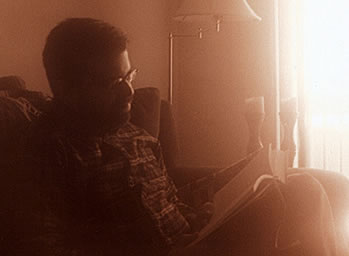
M. Bennardo, editor, reads a book unpretentiously at home. Photo by K. Sekelsky.
Can you tell us a little how the reading process works?
We’ve had a couple questions about this, and the answer is that all the stories are read by the three of us (that’s Ryan, Matt and David !). We don’t have any readers or assistants or freelance editors helping out – it’s just us. We’re not sure yet how to train somebody else to pick the kind of stuff that we would like, so that’s why we want to do it ourselves. Besides that, it’s a lot of fun.
Right now, we’re getting between five and seven stories a day, so we’ve been able to keep up pretty well with the incoming volume. As we get closer to the deadline, I’m expecting that we’ll receive more stories each day and that they’ll be longer on average. Depending on how many stories come in later, we may start dividing the reading duties. (We had to do this last time during the heaviest weeks or we never would have finished the reading in a reasonable amount of time.) It’ll still be just Ryan, Matt, and David ! reading the stories and every single story will get read – but it might only be read by one or two of us instead of all three. So if you want to make sure that all of us get a chance to read and fall in love with your story, I recommend sending it in sooner rather than later!
There’s another reason to send your stories in sooner, too. As soon as we read a submission, we make some notes about our impressions – what we liked, what we weren’t sure about, how we think the story will contribute to the book overall. Sometimes these notes spark discussion and debate. Sometimes a conversation about one story continues when we read other similar stories later. But the earlier we read your story, the more time we have to talk and think about it, and the more time we have to fall in love with it. You should definitely only submit your story when you think it’s finished – don’t rush it! But if you have the chance to get it in earlier, it might be to your benefit!
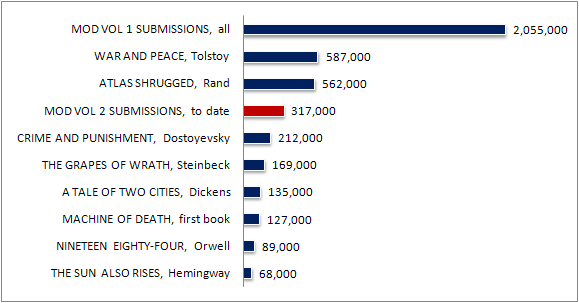
Comparative word counts of submissions received so far versus great works of literature. Help us put Ayn Rand’s verbosity to shame!
Is there anything you want to see more of?
I don’t want to give out any specific writing prompts because we’ve already supplied plenty of guidelines. And the stories we’ve read so far have been very creative and diverse, so I don’t even have any unfulfilled wishes in that department – except to continue to be surprised. But here’s what I can report so far.
Most stories are short. Since submissions have only been open for a little more than two weeks and since longer stories take more time to write, this is not really surprising or troubling. The average word count right now is a little over 3,100 words, which is just perfect for lots of stories. We would never encourage anybody to stuff padding into a tight story just to increase the word count. But I’m looking forward to the longer stories as well, since they bring a different flavor to the soup. So don’t be afraid to submit a 5,000 or 7,000 or even 10,000 word story if that’s how long it needs to be! (Anything over 10,000 words might be difficult to fit into the book, so you may want to consider that an upper limit.)
People live in different places. We’ve been tracking demographics as much as we can with this batch of submissions. We didn’t really pay attention to this dimension the first time around, so there have been some interesting discoveries. So far, we’ve gotten stories from people living in eight different countries on three continents. We’re still waiting for our first submissions from Asia, South America, and Africa. And if anybody in Antarctica has the time and an Internet connection – that would be incredible! (Dare I even suggest the possibility of submissions from the International Space Station?) It’s pretty neat to know that folks all over the world are interested in this book. We hope we only get more diversity!
Women are underrepresented. The other interesting piece of data that surfaced is that so far only 22% of the submissions are written by women. (As far as we can tell. We’re using first names and hints from the short bios to determine sex, so there’s another 5% – 10% that we can’t be sure of.) This was kind of an eye-opening moment for us, so we tried to do some more research into this. One source of data that we found is Strange Horizons, which has summarized its submission statistics for years now. In 2010, they reported that 30% of their submissions were from women and another 13% were unknown. Clearly, they’re doing better than we are when it comes to attracting women writers – but even their numbers are pretty troubling.
We’re new to this editing thing, and as independent editors we don’t even have access to the same industry resources and experience as other publishers might. So we don’t really know what this means or how to explain it. We could speculate, sure – but that’s just so much hot air without more data to back it up. We also don’t know if there are similar entrenched disparities that aren’t so easy to pick out using contact info – our submissions might also be disproportionately weighted to writers of a particular age, race, sexual orientation, religious belief, political affiliation, or educational background. We would have no idea.
So I’m going to end with a two-part call to action. First, we know that women are underrepresented in our submissions, so if you are friends with an amazing writer who is also a woman, please encourage her to submit a story to us! And second, if you are friends with any amazing writer of any sex, age, race, and all those other things, please encourage him or her to submit as well! There are no doubt many viewpoints and experiences that are underrepresented in fiction today, but the only way we’ll ever get a chance to bring them to the world is if they are submitted to us in the first place.





